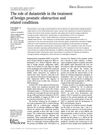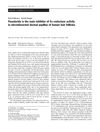TLDR The method accurately measures testosterone metabolites with high sensitivity and low environmental impact.
The study developed a methodology for directly quantifying testosterone metabolites in the pilosebaceous unit using digital autoradiography, which allowed for the detection of signals as weak as 25 dpm and calibration curves in the range of 50–500 dpm. The technique demonstrated high sensitivity, reproducibility, and practicability, with coefficients of variation not exceeding 10% for biological measurements. This method provided a comprehensive analysis of testosterone metabolism into its various derivatives and offered an environmental advantage by minimizing the use of radioactive materials.
 38 citations
,
July 1989 in “Archives of dermatological research”
38 citations
,
July 1989 in “Archives of dermatological research” Testosterone causes hair loss in AGA mice, which are good for testing baldness treatments, and both minoxidil and cyproterone acetate can prevent this hair loss.
69 citations
,
August 1988 in “Journal of Investigative Dermatology” 39 citations
,
July 1987 in “Journal of Investigative Dermatology”
 67 citations
,
November 2019 in “Molecules”
67 citations
,
November 2019 in “Molecules” Tea, especially green tea, shows promise in cosmetics for skin and hair benefits but more research is needed for effective use.
 65 citations
,
February 2009 in “The journal of investigative dermatology/Journal of investigative dermatology”
65 citations
,
February 2009 in “The journal of investigative dermatology/Journal of investigative dermatology” Anti-acne medications may work by reducing the activity of a protein involved in acne development.
 127 citations
,
January 2013 in “PLOS ONE”
127 citations
,
January 2013 in “PLOS ONE” Probiotic bacteria improved skin and hair health in aged mice.
 October 2006 in “Aging Health”
October 2006 in “Aging Health” Dutasteride effectively treats benign prostatic obstruction, improves urinary flow, reduces prostate size, and may prevent prostate cancer, but can cause sexual side effects.
 28 citations
,
February 1999 in “Archives of Dermatological Research”
28 citations
,
February 1999 in “Archives of Dermatological Research” Finasteride potentially treats hair loss by reducing DHT production.





